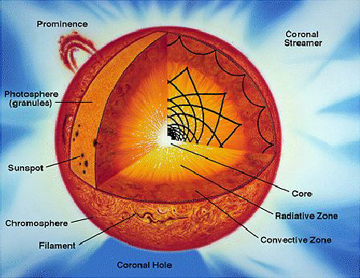nbsp;
|
|

The Sun's Layers and Temperatures
The Sun is a huge ball of gas. Unlike Earth, it doesn't have a solid surface where we could stand——even if it were cool enough. And, just like a golf ball, the Sun is made up of layers: a core, a surface, and surrounding atmospheric layers, each of which have their own layers.
 |
Diagram of the Sun
|
- Core:
- the temperature at the very center of the Sun is about 27 million degrees Farenheit (F). The temperature cools down through the radiative and convective layers that make up the Sun's core.
- Surface:
- the photosphere layer is the most visible to the human eye. Here the temperature is only about 10,000 degrees F. This layer, which looks like a bright disk, sends light and heat to Earth. The photosphere's outer edge seems to be less bright, a condition called "limb darkening." It is on this limb that we see sunspots, dark blemishes on the Sun's surface. Seen through a telescope, the photosphere has a granular appearance. These granules are small convection cells——about 1000 kilometers (just over 621 miles) across——that carry the energy from below the apparent surface. Granules cover the entire Sun except for those areas covered by sunspots.
- Atmosphere:
- the chromosphere is the innermost atmospheric layer. It is just above the photosphere. Here the temperature begins to rise again, to about 36,000 degrees F. Above the chromosphere is the transistion layer, where temperatures increase 6000 to over half-a-million degrees. Gases in this layer shine in the ultraviolet and extreme ultraviolet
wavelengths. The outermost atmospheric layer is the corona, which gets really hot, almost 2,000,000 degrees F. This is where the solar wind begins. These layers can only be seen during total solar eclipses. Here is where we see
towering masses of luminous gas, called filaments or prominences, on the solar limb against the dark sky.
While the center of the Sun's core can get as hot as 30 million degrees F, its outer layers cool down. The photosphere, which is outside the core, is the coolest layer. This is as expected, because normally heat passes outwardly from hot to cold. However, the Sun's outermost atmospheric layer is much hotter than its surface layer! Astronomers have puzzled over this enigma for more than 50 years. What is happening on the Sun?
Scientists still aren't quite sure. They do know that within the innermost core, energy is generated by nuclear reactions. The energy generated and stored in the core diffuses (spreads) outward by radiation (mostly gamma-rays and x-rays) into the next layer, the photosphere——the most visible surface of the Sun——and beyond. Here, gaseous layers change from being completely opaque (blocking light) to a radiative (particle/wave energy) condition to being transparent (admitting light). In the chromosphere, the rising heat causes hydrogen to give off the reddish light seen in the prominences during solar eclipses. And, the corona, which extends for millions of miles beyond the relatively cool photosphere, is even hotter. While there are differing opinions on the causes of the corona's extreme temperatures, most scientists now attribute it to the interaction of the Sun's magnetic field lines.
Back
|
|
|
|